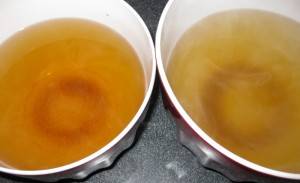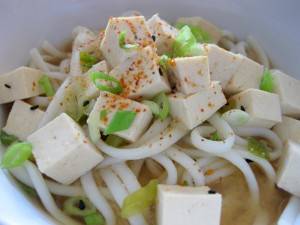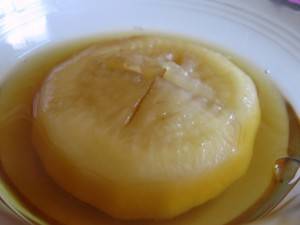 A few weeks back, I described what dashi is and how it’s made. No ingredient is worth having around if you don’t know how to use it, and that’s what you’ll learn here. Just like any meat stock, which can be used in applications ranging from making sauces to being a braising liquid, there are so many ways to use dashi. One of the most commonly-found applications is soup, but it makes a great braising liquid or sauce medium.
A few weeks back, I described what dashi is and how it’s made. No ingredient is worth having around if you don’t know how to use it, and that’s what you’ll learn here. Just like any meat stock, which can be used in applications ranging from making sauces to being a braising liquid, there are so many ways to use dashi. One of the most commonly-found applications is soup, but it makes a great braising liquid or sauce medium.
Just as chicken stock could be a base for comforting soups from chicken noodle to vichyssoise, dashi can be a more- or less-prominent ingredient. A staple of Japanese restaurants is the humble miso soup. At its most simple, miso soup contains little more than dashi, miso, some cubes of tofu, reconstituted wakame, and sliced green onions. Like many simple dishes, miso soup can be a starting point for lots of other soups.
If you’ve never had it, miso seems like a pretty mysterious ingredient. It’s found in the refreigerated section of Asian markets, and can be found in many varieties. Miso is a paste made by salting and fermenting soybeans and/or grains (like rice or barley). The most commonly-used varieties are soybean-based. There are different varieties of Japanese miso, with names like shiro (white) miso or aka (red) miso. They all have somewhat different flavors and may have different things added. White miso is usually sweeter and milder, so miso virgins may want to start there. The best effect is acheived by mixing two or more types.
Use these recipes as a starting point, but explore the possibilities of dashi in your everyday cooking. Poach a chicken breast in it, puree in some spinach when you make miso soup. Use it any time you might otherwise use chicken or fish stock. Use it to soften up a few tablespoons of miso and brush it on a piece of fish or meat before (or after) cooking. Hopefully dashi is the beginning and not the end, of your Japanese culinary adventures.
 Miso Udon
Miso Udon
serves 2 or 3
- 1-2 bundle(s) of thick udon
- 3 c dashi
- 1 block tofu, cut into 1/2 inch cubes
- 4 T miso (white, red, or a combination of the two)
- 3 green onions, thinly sliced at an angle
- togarashi (7-spice powder, optional)
- Cook the udon according to the package directions (usually boil for 6-8 minutes). Drain and rinse under cold water to cool and wash off excess starch.
- Heat the dashi in a medium saucepan until barely simmering. Reduce heat to maintain bare simmer.
- Add tofu and cook for a couple minutes to heat through.
- Add the miso and stir to combine.
- Add noodles to bowls and ladle in soup, making sure to distribute the goodies evenly.
- Garnish with green onions and togarashi, if using.
 Furofuki DaikonFurofuki Daikon (Braised Daikon)
Furofuki DaikonFurofuki Daikon (Braised Daikon)
serves 4 as a side
- 1 pound of daikon
- 2 quarts water
- 1 4″x4″ square kombu
- 3 c dashi
- 3 T soy sauce
- 2 T mirin (sweet rice wine)
- 2 T sugar
- Cut the daikon into 1 to 1 1/2 inch rounds and peel them. Slice a cross on one side to help them cook more quickly and evenly.
- (optional) Cut a small bevel on the corners of the daikon.
- Add daikon and water to a saucepan.
- Bring to a boil and cook until just fork tender.
- Drain gently.
- Place kombu in pan, arrange daikon on top, and add remaining ingredients.
- Bring to a boil and then simmer for 10-20 minutes until daikon is very tender.
- Serve with some of the simmering liquid.








